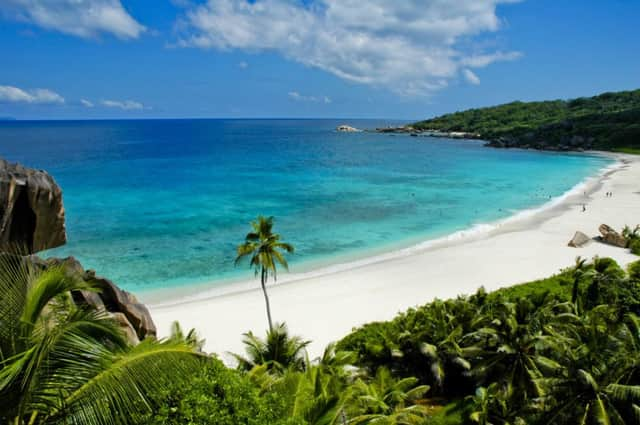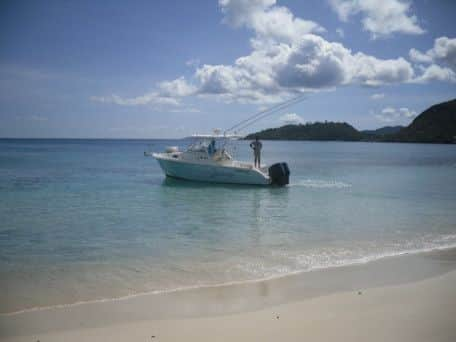Travel: An idyllic retreat to Seychelles


I’m not one for beach holidays. All that lounging around doing nothing, getting sand in places I didn’t think possible; it’s just not my cup of tea. So when a trip to Seychelles came up, with the promise there would be more to these islands than just sunbathing, I thought I was the very person who needed convincing.
Like their distant neighbours in the Indian Ocean, the Maldives, the Seychelles islands are regarded as an idyllic honeymoon destination, where you can relax, eat, scuba dive and then relax some more. It was good enough for Mr and Mrs Clooney and Kate and Wills after all. But as I found out, there’s so much more to see and do here. I didn’t have an island all to myself but the beautiful Raffles Praslin resort was the next best thing.
Advertisement
Hide AdAdvertisement
Hide AdRaffles has 86 villas dotted across the hillside on Seychelles’ second largest island. Have no fear, you’re not expected to hike up and down as chauffeured golf buggies are on hand to take you from door to door, and this is how I arrive at my luxurious temporary home. Surrounded by lush vegetation and completely secluded from all other guests, I’m greeted with an infinity plunge pool and an unspoilt view of the neighbouring hills and turquoise waters below.


Sliding glass doors lead inside to the large, tastefully decorated bedroom, and in the bathroom there is a spectacular floor to ceiling window. Some villas have a view across the water but from mine there’s jungle. Giant green palm leaves and red flowers press against the glass making a soak in the tub a surprising way to do a spot of bird watching.
Our first day is all about relaxation, thank goodness, because after 32 hours of travelling I’m not fit for much else. A Hot Seashell Therapy massage in Raffles spa is followed by an afternoon on the resort’s white sandy beach, Anse Takamaka. The calm waters in the bay make it an ideal place for snorkelling and kayaking and it is also the setting for the occasional wedding. Even I am quite happy to while away the afternoon in these peaceful surroundings. For the evening we are treated to a BBQ buffet in Losean restaurant featuring locally sourced seafood and hog roast, all washed down with “Girls just want to have rum” cocktails. There are three restaurants at Raffles Praslin, providing contemporary Mediterranean, pan- Asian and traditional Creole cuisine that is native to Seychelles.
The following morning begins with a healthy breakfast at Pti Zil Beach bar before boarding our private speedboat. We zoom across the water to Aride Island, where we are met by Rodney and his team of environmental scientists. Six people live permanently on the island to monitor the local wildlife. Aride is a bird watchers’ paradise. A former coconut plantation, it was purchased by Christopher Cadbury, of the chocolate family, in 1973 in order to protect the seabird colonies. The responsibility of maintaining its unspoilt beauty was passed on to the Island Conservation Society of Seychelles in 2004 and now a million birds make it their home. It hosts more than 750,000 pairs of ten breeding seabird species, several thousand frigatebirds and five species of land birds, including the very rare magpie-robin. At one time there were just 12 magpie-robins left here, but thanks to Rodney and his team providing food and fresh water daily, there are now 250. With no predators, the birds make their nests in the rotting palm trunks and hawksbill turtles lay their eggs along the coastline. We were lucky enough to see a turtle make her way up the beach, a rare sight in the middle of the day and so close to the eco village where the team are based.
Another island renowned for its wildlife and natural beauty is Curieuse Island. Along with Praslin, this is the only place in the world where you will find the coco de mer palm and its giant seeds. Curieuse started out as a leper colony and was used in this way until 1965. Anse St Jose, a house near the beach, was originally the residence of the doctor in charge, a Scot named William McGregor, and is now a small museum. There is only one human inhabitant remaining among the crabs and 300 giant tortoises that can be found chilling out on the beach and in the picnic area. From a distance the landscape looks like it is dotted with boulders but then they slowly and cumbersomely start moving. The larger tortoises, with dented shells caused by falling coconuts, can pick up surprising speed when presented with food and enjoy the underside of their necks being tickled. Meanwhile the babies are kept under lock and key to prevent tourists popping them in their bags as a souvenir.
Our final day in Seychelles was to be spent on the island of La Digue. It is home to some of the best beaches in the world, including Anse Source d’Argent, which has been the location for many fashion shoots and films including Castaway, starring Oliver Reed. Vanilla and copra were the main contributors to the economy here and they are still produced on a small scale. Copra is the meat of the coconut, dried in a kiln and then ground, traditionally using an ox-powered press to release the coconut oil. Many tourists hire bicycles to get around the island or take an ox cart, but with our tour guide going AWOL, a local man named Derek, adorned with dreadlocks, shades and khaki string vest came to our rescue. He knows everything about the island, being a former tour guide himself, and has the ability to prise open a coconut with his bare hands. He leaves his young son with his granny, loads us on to the back of a truck, and our tour begins.
We travel all over La Digue, up into the hills to admire the view across to the other islands and down to the dramatic coastline. The tropical landscape is like something from Jurassic Park with huge granite boulders balancing precariously overhead, and framing the white sandy beaches. Looking at images like this, it’s easy to see why this idyllic setting and that of the other islands of Seychelles draw people from all over the world.